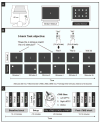Causal evidence supporting functional dissociation of verbal and spatial working memory in the human dorsolateral prefrontal cortex
- PMID: 24713032
- PMCID: PMC4043922
- DOI: 10.1111/ejn.12584
Causal evidence supporting functional dissociation of verbal and spatial working memory in the human dorsolateral prefrontal cortex
Abstract
The human dorsolateral prefrontal cortex (dlPFC) is crucial for monitoring and manipulating information in working memory, but whether such contributions are domain-specific remains unsettled. Neuroimaging studies have shown bilateral dlPFC activity associated with working memory independent of the stimulus domain, but the causality of this relationship cannot be inferred. Repetitive transcranial magnetic stimulation (rTMS) has the potential to test whether the left and right dlPFC contribute equally to verbal and spatial domains; however, this is the first study to investigate the interaction of task domain and hemisphere using offline rTMS to temporarily modulate dlPFC activity. In separate sessions, 20 healthy right-handed adults received 1 Hz rTMS to the left dlPFC and right dlPFC, plus the vertex as a control site. The working memory performance was assessed pre-rTMS and post-rTMS using both verbal-'letter' and spatial-'location' versions of the 3-back task. The response times were faster post-rTMS, independent of the task domain or stimulation condition, indicating the influence of practice or other nonspecific effects. For accuracy, rTMS of the right dlPFC, but not the left dlPFC or vertex, led to a transient dissociation, reducing spatial, but increasing verbal accuracy. A post-hoc correlation analysis found no relationship between these changes, indicating that the substrates underlying the verbal and spatial domains are functionally independent. Collapsing across time, there was a trend towards a double dissociation, suggesting a potential laterality in the functional organisation of verbal and spatial working memory. At a minimum, these findings provide human evidence for domain-specific contributions of the dlPFC to working memory and reinforce the potential of rTMS to ameliorate cognition.
Keywords: dorsolateral prefrontal cortex; functional neuroanatomy; functional specialisation; repetitive transcranial magnetic stimulation; working memory.
© 2014 Federation of European Neuroscience Societies and John Wiley & Sons Ltd.
Conflict of interest statement
The authors declare no competing financial interests.
Figures




Similar articles
-
Lateralized contribution of prefrontal cortex in controlling task-irrelevant information during verbal and spatial working memory tasks: rTMS evidence.Neuropsychologia. 2008;46(7):2056-63. doi: 10.1016/j.neuropsychologia.2008.02.003. Epub 2008 Feb 8. Neuropsychologia. 2008. PMID: 18336847
-
Unilateral repetitive transcranial magnetic stimulation differentially affects younger and older adults completing a verbal working memory task.J Neurol Sci. 2018 Jan 15;384:15-20. doi: 10.1016/j.jns.2017.10.021. Epub 2017 Oct 20. J Neurol Sci. 2018. PMID: 29249371
-
Effects of repetitive transcranial magnetic stimulation on memory subtypes: a controlled study.Neuropsychologia. 2003;41(14):1877-83. doi: 10.1016/s0028-3932(03)00131-3. Neuropsychologia. 2003. PMID: 14572521 Clinical Trial.
-
The role of dlPFC laterality in the expression and regulation of anxiety.Neuropharmacology. 2023 Feb 15;224:109355. doi: 10.1016/j.neuropharm.2022.109355. Epub 2022 Nov 26. Neuropharmacology. 2023. PMID: 36442650 Free PMC article. Review.
-
Repetitive transcranial magnetic stimulation (rTMS) as a tool for cognitive enhancement in healthy adults: a review study.Med Biol Eng Comput. 2024 Mar;62(3):653-673. doi: 10.1007/s11517-023-02968-y. Epub 2023 Dec 4. Med Biol Eng Comput. 2024. PMID: 38044385 Review.
Cited by
-
Concordance Between BeamF3 and MRI-neuronavigated Target Sites for Repetitive Transcranial Magnetic Stimulation of the Left Dorsolateral Prefrontal Cortex.Brain Stimul. 2015 Sep-Oct;8(5):965-73. doi: 10.1016/j.brs.2015.05.008. Epub 2015 May 29. Brain Stimul. 2015. PMID: 26115776 Free PMC article.
-
Alpha oscillatory activity is causally linked to working memory retention.PLoS Biol. 2023 Feb 13;21(2):e3001999. doi: 10.1371/journal.pbio.3001999. eCollection 2023 Feb. PLoS Biol. 2023. PMID: 36780560 Free PMC article.
-
TMS provokes target-dependent intracranial rhythms across human cortical and subcortical sites.bioRxiv [Preprint]. 2023 Nov 19:2023.08.09.552524. doi: 10.1101/2023.08.09.552524. bioRxiv. 2023. Update in: Brain Stimul. 2024 May-Jun;17(3):698-712. doi: 10.1016/j.brs.2024.05.014. PMID: 37645954 Free PMC article. Updated. Preprint.
-
Rostral anterior cingulate cortex is a structural correlate of repetitive TMS treatment response in depression.Brain Stimul. 2018 May-Jun;11(3):575-581. doi: 10.1016/j.brs.2018.01.029. Epub 2018 Jan 31. Brain Stimul. 2018. PMID: 29454551 Free PMC article. Clinical Trial.
-
Disturbed effective connectivity patterns in an intrinsic triple network model are associated with posttraumatic stress disorder.Neurol Sci. 2019 Feb;40(2):339-349. doi: 10.1007/s10072-018-3638-1. Epub 2018 Nov 17. Neurol Sci. 2019. PMID: 30448966
References
-
- Abler B, Walter H, Wunderlich A, Grothe J, Schönfeldt-Lecuona C, Spitzer M, Herwig U. Side effects of transcranial magnetic stimulation biased task performance in a cognitive neuroscience study. Brain Topogr. 2005;17:193–196. - PubMed
-
- Baayen RH, Davidson DJ, Bates DM. Mixed-effects modeling with crossed random effects for subjects and items. J Mem Lang. 2008;59:390–412.
-
- Baddeley The episodic buffer: a new component of working memory? Trends Cogn Sci. 2000;4:417–423. - PubMed
-
- Baddeley AD, Hitch G. Working Memory. Academic Press; 1974. pp. 47–89.
Publication types
MeSH terms
Grants and funding
LinkOut - more resources
Full Text Sources
Other Literature Sources

